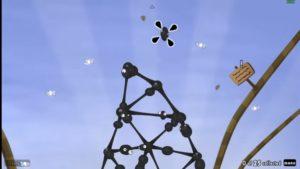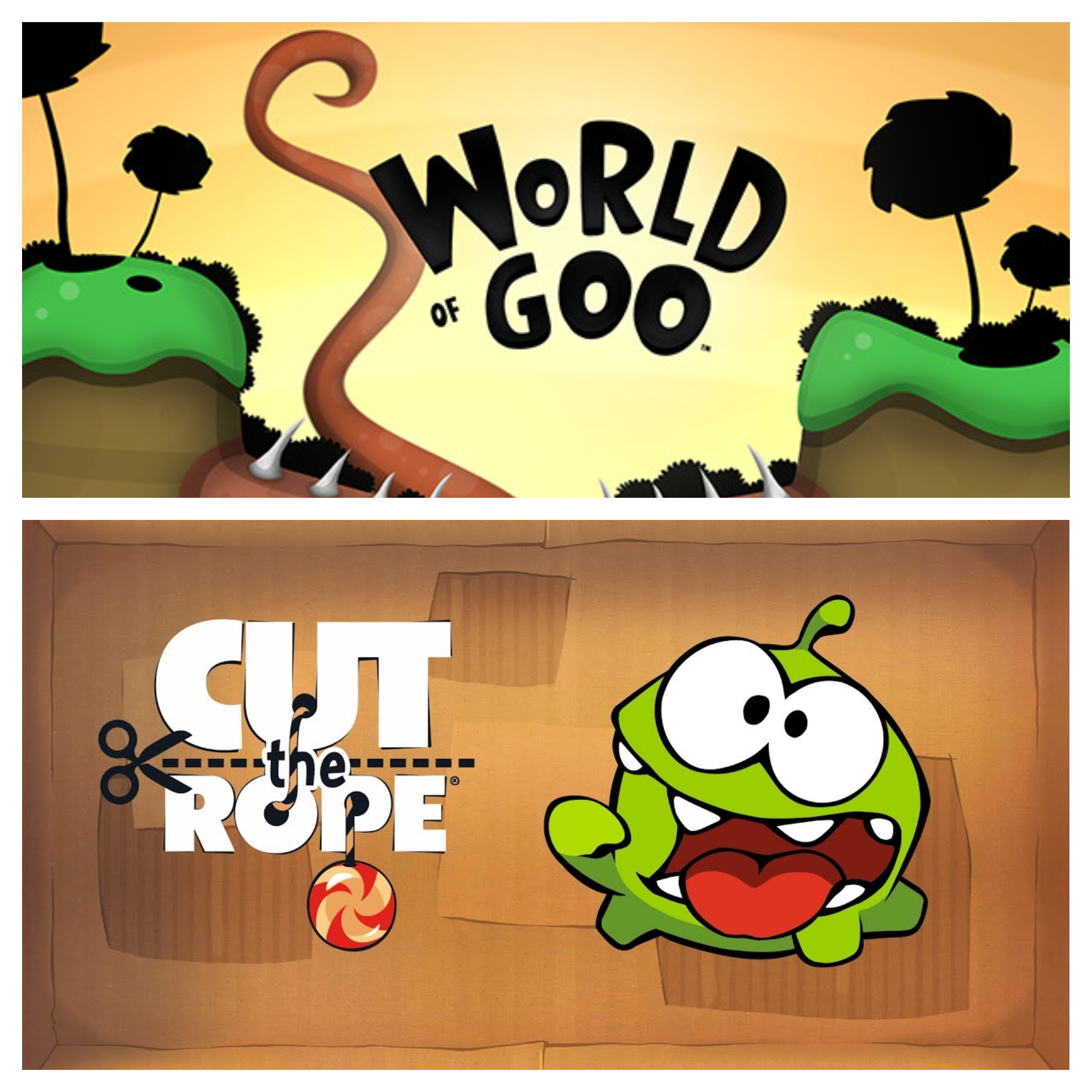World of Goo
World of Goo is a physics-based puzzle game made by 2D Boy. It’s a digital game that I played on the Iphone IOS platform [source].
Cut the Rope is a physics-based puzzle game made by Puzzle Logic that I played on the IOS platform [source].
Theme
The theme of World of Goo is best represented as a puzzle game that relies on a player to use their knowledge of basic physics principles i.e. gravity to solve them.
The theme of Cut the Rope is similar to World of Goo in that the the theme of the game belies how the player must use their familiarity of physics principles, mostly Newton’s laws, to solve puzzles.
To clarify, in both games, actual knowledge of physics is not required; however, the games rely on players using critical thinking and reflection of how objects function in their own lives to understand how the objects would operate in the game i.e. what happens in reality seems to happen (for the most part, physics-wise) in the game.
How does the theme change the experience?
As a reading I did from the GDCVault posits, “a game’s theme only matters if the mechanics enlighten us about it” [source]. This is how the theme affected the playing experience for me in both, through its mechanics.
Regardless of the differences in premise of each game, one focused on oil spills, the other on feeding a creature a candy, the games have similar mechanics that bring the “physics” theme alive and use this theme to help players solve the puzzles.
These mechanics are the following:
- The role that the player has in controlling the main objects and the materials within the game’s landscape
- The way the game presents objectives to the players
These mechanics highlighted the theme of the games and showed me how my familiarity with the physics (or rather how our world works) could make solving the puzzles much more intuitive.
The role that the player has in controlling materials:
In World of Goo, I was able to manipulate the landscape however I wanted, maneuvering the oil blobs into whatever structure I wanted to make (see photo below) to get from the start to the finish. By understanding that the physics principles that govern our world govern this fantasy world as well, I knew that I could rely on this assumption to build structures I think would be effective in our world. This directly helped me concoct bridges or structures where I would make the base of the bridge bigger (made with more blobs) and the tops with less blobs (a pyramid shape is sturdier than if the base is smaller and the top is bigger).

In Cut The Rope, I relied on knowing that due to gravity and tension, objects fall and swing. Therefore, in the game, I saw the tension of ropes due to their different coloring and knew that based on the height of the ball attached to the rope that it would swing right into the creature’s mouth. Furthermore, since multiple ropes attach to the ball sometimes, I had to see which rope would most likely ‘arc’ when it was cut so that it would cause the ball to fall appropriately.


The way the game presents objectives to the players:
In World of Goo, the most evident manifestation of the theme is in the type of materials that the player must interact with. The best example of this is the vacuum, suction contraption that sucks up the oil and solves the level. The vacuum-like behavior is a clear nod to how vacuums work in reality, inhaling things put near it and not dispelling them. A player who is familiar with this type of behavior, anyone who knows the idea of suction or has ever used a straw would know that when something is sucking in, things around it go into that thing. When the player has to solve a level, they simply need to bring the oil near the suction and, just as in reality, the oil will be sucked into the strong vacuum. This highlights how theme changes the experience: the “physics” foundation helps the player understand that “oh I need to bring my oil drops near this cone-shaped suction device that seems to be taking in air; from my personal experience of suctions and physics properties, I think bringing the oil near it will cause the oil to go up the suction.”

If I had no idea how this world worked, which scientific laws govern it, I could have easily surmised that the goo will not be sucked up the device and could possibly push the goo away. I would have then found the game much less intuitive and purposefully confusing, especially since the same presents the object for completing a level, the cone-shaped suction, like a suction/vacuum valve from the real-world.
In Cut the Rope, the game relies on players’ familiarity with tension and gravity to solve the puzzles. The game presents the object of feeding the creature through positioning it in a place where one can see how different ropes could facilitate a “pendulum” effect, swinging the candy into the creature’s mouth. This behavior, of the rope swinging the candy back and forth, is reminiscent of Newton’s cradle and shows the player that they can rely on their knowledge of physics to solve the problems.
Type of Fun
In both games, one of the most evident types of fun is “challenge” given that the games are based on solving puzzles. Both definitely accomplished their goals, because I not only found that the puzzles were adequately stimulating, but they were also appropriate in difficulty: they gradually got tougher without introducing interaction loops that the player had never confronted previously. I particularly enjoyed how I didn’t need to rely on remembering game-specific rules for how things operate; I could rely on my knowledge of gravity and some good estimates to solve many of the puzzles, and weirdly, this felt rewarding.
Conclusion
In both games, the use of physics principles helps players solve the puzzles and proves to be the integral part of the games. This theme impacts how the game develops its challenges as well: if these games added puzzles that did not involve physics and instead focused on, for example, a fantastical storyline with flying creatures and no gravity, it would totally disrupt the game and the player’s understanding of it. It is the deep mirroring of our world and the world in these games that provides such a rewarding experience, and for both of these games, the medium for the mirroring is through keeping the laws of physics relevant in their worlds.



